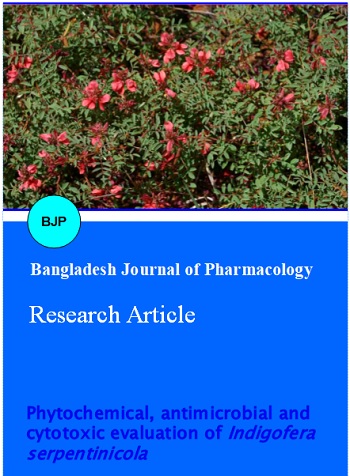Phytochemical, antimicrobial and cytotoxic evaluation of Indigofera serpentinicola
DOI:
https://doi.org/10.3329/bjp.v10i1.21467Keywords:
Antimicrobial, Cytotoxicity, Indigofera serpentinicola, PhytochemicalAbstract
Methanol and aqueous root extracts of Indigofera serpentinicola were investigated for their phytochemical, antimicrobial and cytotoxic properties. Phytochemical analysis showed the presence of alkaloids, saponins, tanins, terpenoids, cardiac glycosides, phenols, reducing sugars oils and fats in both extracts. Flavanoids were only detected in the methanolic extract. Antimicrobial activity was evaluated using the Kirby-Bauer disk diffusion method. The extracts showed low activity against Staphylococus aureus, Cornybacterium diptheriae, Pseudomonas aeruginosa and Salmonella enterica and no activity against Escherichia coli. The diameters zones of inhibition ranged between 3-10 mm. The aqueous extract had higher activity showing zones of inhibition of 10 mm against S. enterica. Brine shrimp lethality test showed LC50 values which ranged from 0.079-0.158 mg/mL, showing that the extracts were highly toxic.
Downloads
517
320 Read
239

Published
How to Cite
Issue
Section
License
Authors who publish with this journal agree to the following terms:
- Authors retain copyright and grant the journal right of first publication with the work simultaneously licensed under a Creative Commons Attribution License that allows others to share the work with an acknowledgement of the work's authorship and initial publication in this journal.
- Authors are able to enter into separate, additional contractual arrangements for the non-exclusive distribution of the journal's published version of the work (e.g., post it to an institutional repository or publish it in a book), with an acknowledgement of its initial publication in this journal.
- Authors are permitted and encouraged to post their work online (e.g., in institutional repositories or on their website) prior to and during the submission process, as it can lead to productive exchanges, as well as earlier and greater citation of published work (See The Effect of Open Access).
